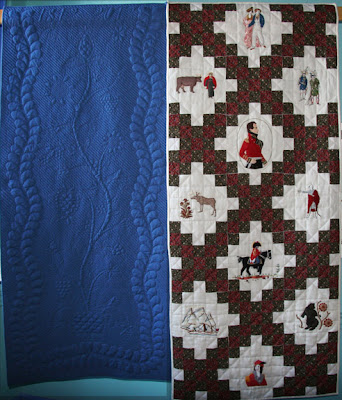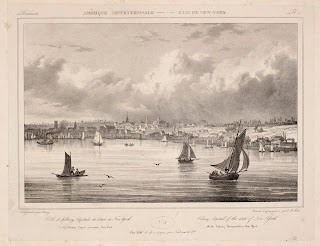 A regiment of Canadian quilters and a Pennsylvania woman have won Viewer’s Choice honors from the Great Lakes Seaway Trail War of 1812 Bicentennial Quilt Show. The show featured 1812 period-correct and pictorial quilts from 18 U.S. states and from across Canada.
A regiment of Canadian quilters and a Pennsylvania woman have won Viewer’s Choice honors from the Great Lakes Seaway Trail War of 1812 Bicentennial Quilt Show. The show featured 1812 period-correct and pictorial quilts from 18 U.S. states and from across Canada.
The favorite quilt of the more than 1,000 visitors to the show hosted by three early 19th century historic sites in Sackets Harbor, a New York State 1812 Heritage Community, was made by nine of the living history interpreters at Upper Canada Village, Morrisburg, Ontario.
Janice Toonders, who demonstrates spinning and weaving at the Village, designed the quilt using an Irish chain pattern. Toonders, Martina Bols, Linda Brown, Mary Casselman, Christine Christie, Ivah Malkin, Marjorie Munroe, Judy Neville, and Sharon Shaver used wool cloth, silk thread and cotton fabrics to fashion symbols from the 1812 time period for the colorful pictorial. Sharon Shaver, the quilting demonstrator at Upper Canada Village, added the binding and quilting.
“British Major Sir Isaac Brock is front and center. Lieutenant General Sir George Prevost is aside as he navigates his horse home in shame for not advancing his troops at Plattsburgh. We have the First Nation’s Confederacy leader Tecumseh and Joseph Brant, the Mohawk Chief who was working with the British to create a nation in the west,” Toonders explains.
The Upper Canada Village quilters also included the sloop “Wolf” that fought in one of the Battles of Sackett’s Harbour. A bear, a moose, a First Nation’s symbol, a British sailor and Laura Secord who notified the British of a U.S. attack are also among the quilt’s storytelling images.
Quilts from four Canadian provinces made up approximately 30 percent of the show’s quilts.
The show’s second Viewer’s Choice winner is the “Underhill Tree of Life Whole-Cloth Quilt” made by Jill C. Meszaros of Cambridge Springs, PA, 25 miles south of Erie and the Great Lakes Seaway Trail Pennsylvania. The all-blue quilt is intricately quilted by hand with a dark blue thread.
Meszaros says, “I chose to create a whole-cloth quilt to honor my family heritage and the history of quilting and our nation. My fourth great-grandfather, Major David Underhill traveled to Huron County, Ohio, in 1810. In 1812 he reacted to the news that the British and Indians were landing only to learn they were really soldiers in Hull’s army. As I quilted, my husband was away and I imagined what it would have been like in 1812 to wait for him to come home.”
Meszaros, a stay-at-home mother of six, fashioned her design after the Clarke Family Quilt in the book “Massachusetts Quilts” and used fruit, floral and foliate motifs inspired by “Quilts-Masterworks from the American Folk Art Museum.” The quilt’s batting is wool, typical of the 1812 time. She says, “The last stitch went in the I day I shipped the quilt to the show.”
Show manager Lynette Lundy-Beck notes, “This show inspired people to learn more about the War of 1812, its battles, the soldiers and their loved ones, and about the quilters’ own families. This show is indeed a storytelling event that interprets the travel themes for the Great Lakes Seaway Trail in many interesting and personal ways, and that is what makes this quilt show unique among quilt shows and tourism showcases.”
Much of the war was fought along the Great Lakes Seaway Trail, a National Scenic Byway in the U.S. The 518-mile leisure driving route parallels the St. Lawrence River, Lake Ontario, Niagara River, and Lake Erie. Quilting is just one of many travel themes for the byway.
Watch www.seawaytrail.com/quilting for details on the impact of the 2012 show and for guidelines on the Beauty of the Byways theme for the 2013 show.
 An exhibition of some thirty-five exceptional American and European quilt masterpieces from the Brooklyn Museum’s renowned decorative arts holdings will examine the impact of feminist scholarship on the ways in which historical quilts have been and are currently viewed, contextualized, and interpreted.
An exhibition of some thirty-five exceptional American and European quilt masterpieces from the Brooklyn Museum’s renowned decorative arts holdings will examine the impact of feminist scholarship on the ways in which historical quilts have been and are currently viewed, contextualized, and interpreted.






